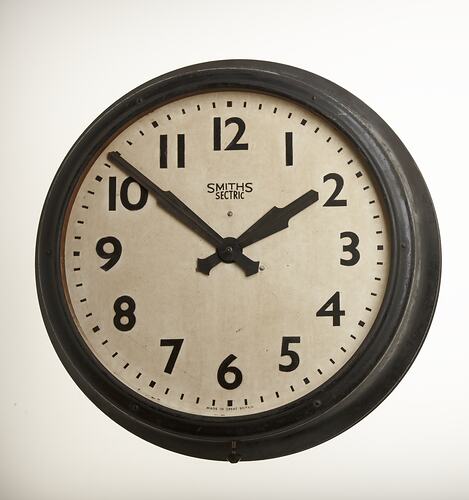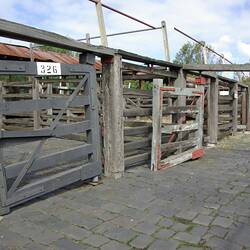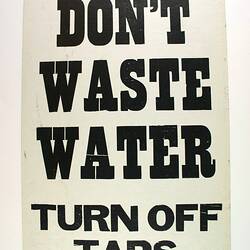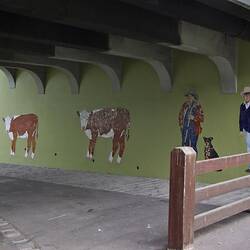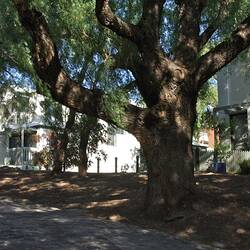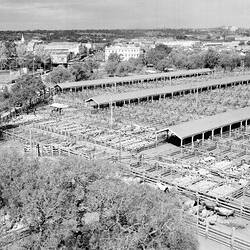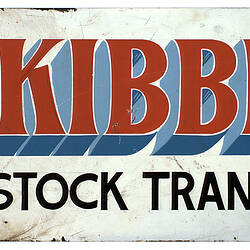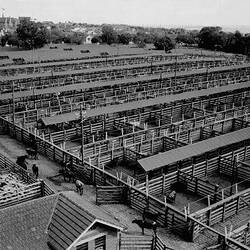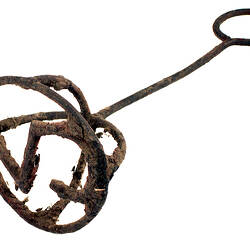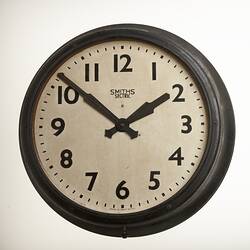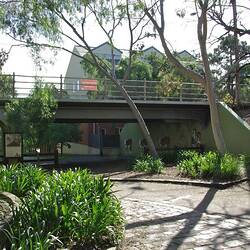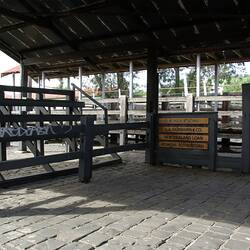1840
By 1840 the city of Melbourne, in the south of Victoria, was nearly five years old. Population growth in Melbourne and the surrounding countryside had been steady, and the population was around 10,000.
Pre 1842
Prior to separation from New South Wales, a Markets' Commission was established which appointed and controlled market sites and systems for the first markets in Melbourne. (Peck 1974:11)
1842
Act 6, Victoria No.7, incorporating the city of Melbourne, transferred the functions of the Market Commissioners to the Melbourne City Council. Sale of butchers' stock transferred to corner of Elizabeth and Victoria Streets under Melbourne City Council. (Peck 1974: 12)
February 9: The official opening of regular stock markets on "a site in Sydney Road". It is most likely that this was the corner of Elizabeth Street north and Victoria Street, where the retail butchers' stalls of the Queen Victoria market now stand. (Peck 1974:11)
August 12: Melbourne Municipal Corporation Act was passed in Sydney. Melbourne City Council is formed.
1849
April 10: Up until this point, slaughter houses were located on Yarra Bank land at the foot of Batman's Hill (10 acres) (near Southern Cross Station); and Batman's Swamp (World Trade Centre). A proposal was made to the Market Committee by residents to erect public abattoirs in an appropriate, central location. Trustees of Flemington Racecourse agreed to provide land on Saltwater River (now Maribyrnong River) for the siting of abattoirs and cattle yards.
1850s
The 1850s saw the beginnings of the great Australian 'gold rush'. As thousands of people flooded to Victoria to discover gold, the population boomed. By 1851 the population exceeded 75,000. Ten years later Victoria's population rose to over 500,000. The gold era evolved Victoria from a sheep grazing economy based around squatters, into an emerging industrial base and small (yeoman) farming community.
1856
Establishment of Newmarket Saleyards introduced an organised system of livestock auctioning for cattle, sheep, pigs and horses. Previously, the livestock had been sold at many different places called marts, bazaars, taverns, inns, hotel yards and livery stables. Act 21 Victoria No. 11 stated: "that the site thus set apart shall be the only space within the City, etc., where cattle shall be sold". Other markets still continued while Newmarket was being established and in 1863 Act 27 Victoria No. 178 empowered the Council "to establish additional cattle markets and to permit the sale of cattle, etc., in auction rooms, or premises of salesmen" under certain conditions. (Peck 1974:12)
August 30: A Crown Grant was made to Melbourne City Council for the site of Newmarket Saleyards (24 acres) in the Doutta Galla Province of Melbourne. The site was situated between Racecourse Road and Epsom Road, with abattoirs adjoining the Saleyards to the south-west. The most south-westerly boundary of the abattoirs adjoined the Maribyrnong River for the discharge of liquid waste.
1857 (late)
Tenders invited for the erection of Newmarket cattle markets. (Peck 1975:12)
1858
Construction of Newmarket Saleyards.
1859
Newmarket Saleyards in operation, capable of accommodating 100 head of cattle and 500 head of sheep.
1860s
Initially all stock travelled to and from Newmarket "on the hoof" by drovers.
1860
Melbourne City Council invites tenders for lease of Newmarket Saleyards. Although not made public, amounts of between £5,000 and £9,000 per annum are recorded. (Peck 1974:12; Vincent 1992:12) Opening of Newmarket Railway Station and siding.
1861
Official opening of Newmarket Saleyards.
Official opening of City Abattoirs, located on 57 acres bounded by Smithfield, Epsom and Westbourne Roads and the Maribyrnong River. Upon opening, the abattoirs were authorised to operate 24 hours per day except Sundays, Good Friday and Christmas Day. (Vincent 1992:14)
1870s
Extension and refurbishing of the Essendon to Melbourne Railway Line. Previously built by a private company only as far as Essendon, the line was extended to Kilmore East by the State Government.
1874
Saleyards Administration Building constructed, still survives today. It is a square planned red brick structure with a central courtyard. The slate roof is hipped and the buildings feature cast iron lacework. On the western side of the building is a series of extensions dating from 1911 and 1919. Part of Newmarket Saleyards Administration Building can be seen in Museum Victoria Newmarket Collection Item MM 112554.
October: Post office opened in the Administration Building. At first the Post Office only operated on Wednesdays but as the Saleyards grew, Tuesdays were also sanctioned. Prior to this, telegraph messages had to be sent to Newmarket railway siding where they were collected by a messenger who was then sent to the saleyards. Later, telegraph facilities were provided on all selling days until the Post Office closed in 1977. (Vincent 1992:24)
Pre 1885
Prior to this date, Melbourne City Council dues have been recorded as: cattle 1/- per head; sheep and lambs 1/- per score, pigs or goats 2d. per head. (Peck 1974:12)
1886
Objections to the Newmarket Saleyards on the grounds of health and safety to residents. (The Argus, July, September, 1886)
1888
March 20: Royal Commission into health and safety of the Newmarket Saleyards established: "Every slaughtering establishment should be outside thickly populated localities". Protests arose against the Melbourne City Council, demanding limits on "any municipal body at one and the same time to draw revenue from abattoirs in its capacity as a council, and to control the sanitary administration of the abattoirs in its capacity as a board of health." (Parliament of Victoria)
1890
Economic downturn in Australia. Lobbying against the Saleyards was put on hold.
1894
Introduction of public auction system at Newmarket.
1897
October: Melbourne City Council takes over control and administration of Newmarket Saleyards. Scale of charges changed to: cattle 9d. per head (reduced); sheep 1d. per head + 6d. per score (increased) for use of yards; pigs 3d. At this stage, goats may have reduced in demand and were no longer were accommodated. (Peck 1974:12; Vincent 1992:12)
October 9: Council voted to undertake collection of dues etc. Dues charged at first by Market Commissioners and afterwards by Melbourne City Council. (Directory of Archives in Australia)
1898 - 1908
Abattoir buildings declared primitive and unhygienic and were replaced by more modern facilities between 1898 and 1908. Nearby, on the river bank, there were factories for boiling-down, fell mongery, bone manure and glue. (Directory of Archives in Australia)
1901
Australian Federation
1910
Board appointed by the Murray Government (John Murray, Victorian Premier 1909 - 1912) to enquire into the "stock markets, abattoirs and slaughtering places, and noxious trades allied or adjacent thereto within the metropolitan area". Report completed September 1911 (The Argus, 24 February 1922). Report further endorsed findings of 1888 Commission and recommended that the grants of lands at Flemington and Parkville to the MCC for stockyards and abattoirs be revoked by act of Parliament and lands be resumed by the Crown. Sometimes referred to as the Morrissey Commission.
1911
Epsom Road Underpass/Bridge was constructed, replacing a level crossing. The Underpass became known as the 'Back Gate' where a stock counter counted the livestock as it passed though after being sold at the Newmarket auctions. Designed John Monash's Company - the Reinforced Concrete and Monier Pipe Construction Co.
1914 - 1918
World War I
1922
Continuing opposition to the Newmarket Saleyards and City Abattoirs. "While it has not been proved that any injury to the health of the inhabitants of the metropolis is caused by the present state of the abattoirs, the condition herein before described cannot exist without evil consequences." (The Argus, 24 February 1922)
1923; 1925
Town Planning Commission endorsed recommendations of Morrissey Commission.
1930 - 1935
The Great Depression in Australia.
1933
August: Footscray municipal council and other civic bodies demand the removal of the Newmarket Saleyards.
1935
June 12: Sir Albert Dunstan (Victorian Premier 1935 - 1945) outspoken against the conditions at the Saleyards. (The Age, 12 June, 1935)
July 20: Royal Commission appointed into the sustainability/suitability of the Newmarket saleyards. Commission notes: "We draw attention to the limited nature of our terms of reference... before public money is expended on any scheme the proper authority should determine whether metropolitan cattle sale yards should be allowed to remain at Newmarket or be removed in accordance with the considered scheme of town planning." (The Argus, 20 July, 1935; The Age, June 19, 1937)
October: Parliament passes act for the trial of two sheep sales per week until 1st March 1936, extended to 1st August 1936. (The Age, February 26, 1936)
1936
February 27: Representatives from Western municipal councils meet to further consider proposal of removal of saleyards from Newmarket to Derrimut.
1939
Clock Tower constructed in open courtyard at Newmarket Saleyards.
1939 - 1945
World War 2 1941 Stockbridge built linking Newmarket saleyards (now Kensington Banks) to Angliss meatworks.
1944
Annual World Record of Sales at Newmarket Saleyards: 2,502,240 sheep; 3,088,658 lambs; 936,066 store sheep; Totalling over 6.5 million sheep
1953
12 December: Single Day Record of Sales at Newmarket Saleyards: 114,280 fat sheep and lambs; 31,643 store sheep; Plus further 20,000 sheep and lambs sold privately before reaching the saleyards on that day; Plus approx 25,000 sheep and lambs arrived too late for the sale and were held over for the following week's Tuesday sale. At least 1,000 railway trucks were required for this day's yarding plus in excess of 300 motor transports. (Vincent 1992:61)
1957
Start of generally dry conditions across parts of Australia that continued for the following decade.
1961
September 6: Victorian Premier Sir Henry Bolte (Premier 1955 - 1972) announces that moving the Newmarket Saleyards to Derrimut would not go ahead. Costs for moving estimated at £8 million. Proposal to provide £1,200,000 for works including: construction of stock bridge over Racecourse Road (future McLennan Overpass), remodel and improve beef and mutton slaughtering and chilling sections in abattoirs. (The Age, September 7, 1961)
1962
Melbourne City Council applies for a full title to the land occupied by Newmarket Saleyards. If Newmarket Saleyards are moved, ownership of land reverts back to State. Premier Bolte supports application to improve Council title. (The Age, July 20, 1962)
1964
McLennan overpass built over Racecourse Road. Named after Mr Lal McLennan, chairman of the Associated Stock and Station Agents of Melbourne. Opened by Sir Henry Bolte, it is estimated that 45,000 sheep and lambs and 4,000 cattle would use the overpass weekly. (Vincent 1992:204)
1965 - 1968
Eastern Australia experiences severly reduced rainfall from 1965 to 1968. The first six months in 1967 were the driest January - June period for the 20th century over large areas of Victoria, south-eastern South Australia, and north-eastern Tasmania. Parts of south-western Victoria were declared drought areas as limited rain and extremely dry conditions continued from mid-September. Crops were depleted and large numbers of stock were moved from western Victoria to Gippsland and parts of NSW. In Melbourne, 1967 remains the driest year in 140 years of records. The drought lingered in Victoria until March 1968 when relief came from rains in late April and May. December 1968 experienced generally greater rainfall across the states which ended the drought.
1973
Annual Record of Sales of Cattle at Newmarket Saleyards: 650,290 cattle
1975
January 16: Prices of beef cattle fall to 'Depression' levels - ¼ of the price in the 1973 beef boom. (The Age, January 16, 1975)
1976
Weekly Yarding Record at Newmarket Saleyards: 22,479 cattle
1977
Newmarket Saleyards Post Office closed.
1982
August: Melbourne City Council advises stock agents it can no longer meet the annual loss on saleyard maintenance and cleaning. MCC has 38 employees and 5 staff officers working full time at Newmarket. (The Age, August 6, 1982)
Innovations and new technology in meat marketing are introduced, including "livestock link" method whereby farmers are paid on a 'dressed weight' basis over the hooks at the abattoir.
1984
November: Official announcement that Newmarket Saleyards are to be closed on 30 July 1985. Ongoing protests and resistance against closing result in an extension of operation until September 1985.
1985
Thursday September 26: Last pen of cattle sold - Pen 13, I lane, by agent Dalgety Farmers where six cattle realised $155 per head and were purchased by D.S.M. Estates of Korumburra.
September: The State Government of Victoria announces that the use of the Newmarket Saleyards would be extended until a definitive closure on 1 April 1987. (Vincent, 1992:123)
1987
Wednesday April 1: Newmarket Saleyards closes.
Museum Victoria is commissioned by the Office of Major Projects to perform a heritage study of the Newmarket site. As a result of this study a salvage process was carried out and Museum Victoria acquired approximately 125 items from the vacated site comprising branding irons, dog muzzles, signs, tools, plans, administrative documents and miscellaneous items.
1987 - 1988
Most of the Newmarket Saleyards are demolished. The only remaining building is the administrative, quarantine and workshop complex, built in 1903.
2011
Saturday February 19: 150th Anniversary - Drovers' Reunion at Newmarket Saleyards.
Sunday February 20: 150th Anniversary - Community Celebrations at Newmarket Saleyards.
References:
Directory of Archives in Australia, http://directory.archivists.org.au/
National Library of Australia, Trove http://trove.nla.gov.au/
Parliament of Victoria, http://www.parliament.vic.gov.au
Peck, HH 1974, "Memoirs of a stockman", Stock and Land Publishing Co, Melbourne.
Vincent, K 1992, "On the fall of the hammer: a personal history of Newmarket saleyards", Lee White ed, State Library of Victoria, Melbourne.
More Information
-
Keywords
-
Authors
-
Article types
